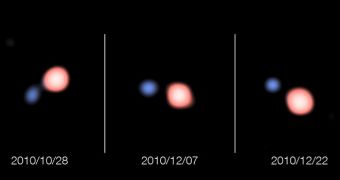Four telescopes at the European Southern Observatory's (ESO) Paranal Observatory, in Chile, managed to collect the most impressive views of a vampire star consuming mass from its companion, inside a binary star system.
Much to the surprise of astronomers who conducted this research, the mass transfer is a lot gentler than first suspected. Observing this process was only made possible by the fact that experts used optical interferometry on the four telescopes.
This is a procedure that allows for light from several sources to be combined in a single field of view. All auxiliary light collectors near the Very Large Telescope (VLT) Interferometer fed their signals into the PIONIER instrument.
The result was a virtual telescope with a diameter of 130 meters (426.5 feet), capable of 50 times the maximum resolution of the NASA Hubble Space Telescope. “We can now combine light from four VLT telescopes and create super-sharp images much more quickly than before,” Nicolas Blind says.
The expert, who is based at IPAG, in Grenoble, France, is also the lead author of the paper detailing the new study. “The images are so sharp that we can not only watch the stars orbiting around each other, but also measure the size of the larger of the two stars,” he adds.
The binary system in question is located in the Lepus constellation, and is called SS Leporis. The two members take around 260 days to orbit each other, and they are only separated by a little more than an astronomical unit. An AU is the mean distance between the Earth and the Sun.
“We knew that this double star was unusual, and that material was flowing from one star to the other. What we found, however, is that the way in which the mass transfer most likely took place is completely different from previous models of the process,” Henri Boffin says.
“The ‘bite’ of the vampire star is very gentle but highly effective,” he adds. The scientist is based at ESO, and was one of the coauthors on the new paper. The work also indicated a novel mechanism to explain the accretion of matter experts see in SS Leporis.
Rather than the hot companion cannibalizing matter from its partner directly, it could be that the latter is releasing much of the material as stellar wind, and its companion is simply accreting it as it moves through space.
“These observations have demonstrated the new snapshot imaging capability of the Very Large Telescope Interferometer. They pave the way for many further fascinating studies of interacting double stars,” study coauthor Jean-Philippe Berger concludes.

 14 DAY TRIAL //
14 DAY TRIAL //